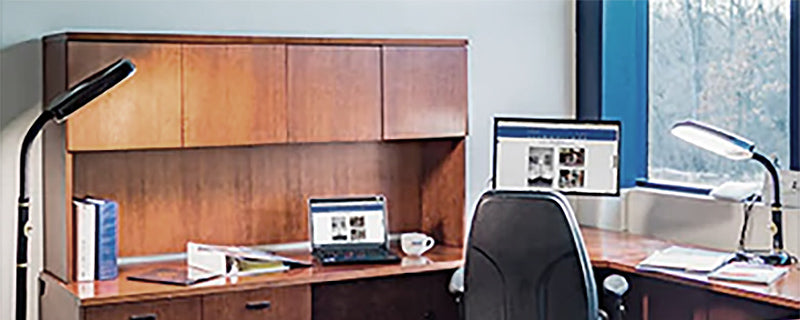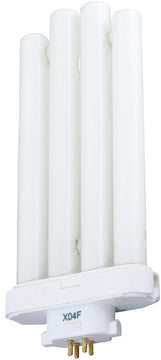Blue max
Blue Max Lighting
Enhance your vision, lift your mood and tackle Seasonal Affective Disorder with a wide spectrum of full-spectrum lamps from Full Spectrum Solutions. Featuring innovative, patented full-spectrum compact fluorescent bulbs offering a bright, sunlight-like illumination, the light quality from these lamps cannot be matched. Order your BlueMax lamp today and watch the savings as their long-lasting light bulbs easily outshine and outlast typical incandescent and halogen bulbs.
BlueMax™ lighting products are a collection of high quality products that produce the highest quality light available today. The BlueMax™ technology was designed based on extensive research throughout the various fields of lighting technology, the science of vision, and human physiological factors. The products are used for general tasks like reading, studying, and more specific tasks like art work, sewing, making jewelry, crafters, and other hobbies that require good visual acuity and color detail. BlueMax™ products produce the highest visual clarity available and are so powerful that they can also be used as light therapy devices.
What is the BlueMax™ light advantage?
BlueMax™ technology is unique in its ability to make your project work area radiant with a clarity unheard of with other lamp brands.
Scotopically enhanced spectrum makes it not only much easier to read, but the words jump off of the page with no eye strain or fatigue. Not only is it easier to see, your artwork or sewing material is crisp and vibrant, just like you were using a magnifying glass, or sitting outside on a sunny day. High CRI of 96 and correlated color temperature of 5900 kelvin makes objects appear as they are supposed to be seen. It is not just better lighting, it's lighting that makes life better!
How does BlueMax™ light work?
The BlueMax™ light uses all of the brilliant qualities of full spectrum light, plus it has three additional phosphors that enhance the fine edges between different colors. Most common fluorescent lights use only one phosphor or color. Some lights use three colors. BlueMax™ uses a total of six phosphors that not only utilize the brilliant qualities of sunlight at noon, but we take that blend and add three additional phosphors. This enhances the scotopic qualities of the light which make it even more clear than regular full spectrum light without the UV. Higher CRI and kelvin temp using balanced multiple phosphors give this light superior clarity. Scotopically enhanced light has been proven to stimulate the eyes photoreceptors increasing visual acuity making this light more comfortable to use while lowering melatonin levels that directly affect energy levels in the body.
Why is Scotopically Enhanced Light important?
In the human eye there are two well-known types of photoreceptors called rods and cones. Until recently, these two receptors were commonly over simplified by saying that the cones are responsible for day vision and the rods responsible for night vision. Nothing could be farther from the truth, however, and some recent efforts by two scientists with differing scientific backgrounds demonstrate unequivocally the important role that the oft overlooked rods have in vision at typical indoor lighting levels. A series of experiments by Dr. Sam Berman and Dr. Don Jewett over the past decade sponsored by the U.S. Department of Energy have highlighted the role that rods play in interior lighting conditions. The tests took place in realistic workplace environments with typical interior lighting and task conditions. These experiments showed that vision acuity can be improved if interior lighting takes into account the role of the rods while performing tasks.
Dr. Berman is a physicist, senior scientist emeritus, and former head of the Lawrence Berkeley Laboratory lighting group. Dr. Jewett is a neurophysiologist and professor emeritus at the University of California Medical Center. In their initial experiments conducted in the mid-1990s they showed that it is the rods that primarily control the pupil diameter of the eye. In subsequent experiments, they found that pupil size, as controlled by the light spectrum in a room rather than the light level, was a factor in visual sharpness under interior lighting. In the seminal study, the pupil sizes of 17 adult subjects were determined as they sat in a chair watching a small television. The subjects were then exposed to various room lighting by altering spectrum, intensity, and wall coloring. Pupil sizes and changes were then measured remotely using thousands of data points for each subject. A near perfect correlation was found based on the relative sensitivity of the rods to different wavelengths (color) of light with the rods being most sensitive to the blue light spectrum. This sensitivity of the rods to blue light is also known as the scotopic response.
Because pupil size follows the scotopic response of the rods to blue light this results in important practical applications for indoor task lighting. Pupil size plays a very important role in human vision, as the smaller the pupil size the better the acuity, the greater the depth of field, and the less the eye has to adjust in order to focus in on a particular object (accommodative response in medical terms). It is common to see the importance of pupil size in practice by individuals through the squinting of the eyes in order to bring distant objects in to focus by manually reducing the size of the pupil. Another illustration of this can be seen by looking at an out of focus object through a small hole in a piece of paper which will bring it into focus. At typical indoor lighting levels, smaller pupil size will permit for better vision. Many assume that by simply increasing light levels you can get a smaller pupil size, but this practice fails to utilize the response of the rods that actually controls the pupil size. Simply ramping up light levels in an attempt to improve vision with normal interior lighting only adds glare reducing visual acuity and wasting energy. The knowledge of both the photopic and scotopic components of vision is necessary to provide an optimal lighting product and that is exactly what the BlueMax technology has done by scotopically enhancing the light output of our lamps.
When lighting is provided for tasks such as computer work, sewing, or reading environments the effects of poor scotopic lighting become even more evident. Bright task lighting, using the common lamps on the market only serves to produce glare and a desaturation of colors. To combat this drowning out of colors and glare it is common for users to decrease or completely remove the surrounding illumination causing the pupils to become larger resulting in poorer vision and visual fatigue due to the additional focus (accomodative response) required by the eyes when the pupils are larger. With proper lighting a person should be able to read, work on the computer, or do detailed crafting work for many hours without any of the eye fatigue, dryness, or soreness that is the typical result of poor scotopic lighting. For task lighting such as this, the lighting needs to be judged purely on the basis of its scotopic qualities that result in the smallest pupils with the least amount of glare and that is exactly what BlueMax™ lighting has done...created the perfect scotopic lighting source for task lighting!
What is CRI to a lay person?
CRI is very similar to your contrast knob on your TV set. High CRI equates to sharper, crisper, more natural colored pictures while at the same time reducing glare. Tech definition: A measurement of the amount of color shift that objects undergo when lighted by a light source as compared with the color of those same objects when seen under a reference light source of comparable color temperature. CRI values generally range from 0(worst) to 100(best).
What is Kelvin or Color Temperature of light?
This is simply the mixture of colors that is displayed. You can also equate this to the color knobs of a TV set. As you adjust these colors, the objects look either more yellow/red and or more blue/green. The research that has been discussed above proves that colors that operate with enhanced blue lighting/scotopic qualities will look more vibrant and clear. Tech definition: A measure of the color of a light source relative to a black body at a particular temperature expressed in degrees Kelvin (K). Incandescent lights have a low color temperature (approximately 2800K) and have a red-yellowish tone; daylight has a high color temperature (approximately 6000K) and appears bluish (the most popular fluorescent light, Cool White, ia rated at 4100K). Today, the phosphors used in fluorescent lamps can be blended to provide any desired color temperature in the range from 2800K to 6000K.
View All Blue max Items or choose a Blue max category below.



